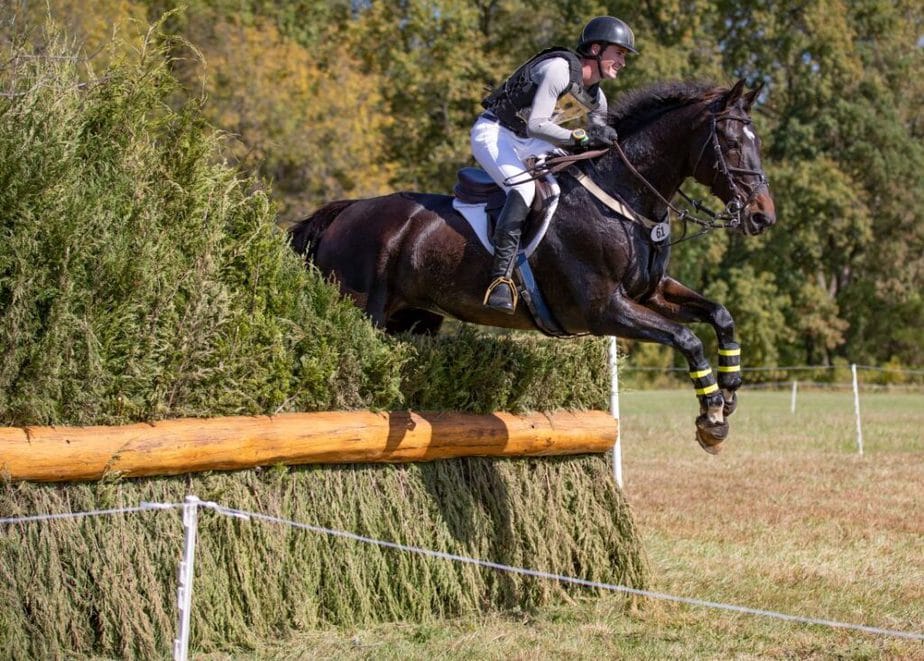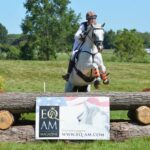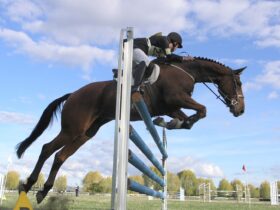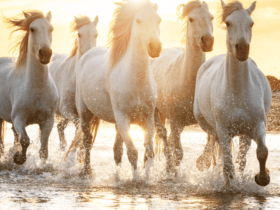Woods Baughman is one of the USEF’s 2020 Eventing 25 Emerging Athletes. As assistant trainer to international 5* event rider, Sharon White, and a 4* eventer in his own right, Woods is up and coming at high speeds. In 2019 he won the CCI3*-L and the Dutta Corp./USEF CCI3*-L Eventing National Championship at the Dutta Corp. Fair Hill International with his horse C’est La Vie 135 and the Virginia Horse Trials CCI3*-L with Sharon’s horse, Masterel. Woods Baughman is young, talented, but above all else―he’s a multi-tasker…
Woods Baughman: Hello.
EQuine AMerica: Hi, Woods. Is this still a good time to talk?
Yeah. I’m just heading out to set up a course, so I can talk. Oh, okay… You can do this at the same time? Oh, for sure.
I have walked a couple of courses. I walked Fair Hill last year. I am majorly impressed by what you guys throw yourselves over at high speeds. Slightly crazy. Yeah. But you’ve been doing it from a young age. How old were you when you started eventing? I started riding when I was six and I just happened to be in an eventing barn. I’d say, I was probably about eight when I did my first event. The only thing I vaguely remember is that it went horribly. Why? What happened? I just remember I finished on 108 points or something like that, which for us, is very, very bad.

For you, higher numbers are bad, right? Like golf. Right, exactly. We take your percent score and subtract it from 100. Then it’s a penalty score instead. So, if we get a 70% in dressage, that’d be a 30-point penalty score. Our dressage score is your normal dressage percentage score but subtracted from 100. At the end of the three phases, we add them all together and whoever has the lowest score wins. That way, each time we have something go wrong, like if you have a rail down in the jumping phase, that’s four penalties added to that score.
So, you had a rough start to the sport? Yeah. The only thing I was too concerned about when I was that young was how fast I could go around the cross country; that part went very well. When you’re a kid, it’s just all about speed and the rush. Exactly, it’s all about having fun. You don’t really know what the sport means. You just know for some reason they didn’t make you the winner. At some point along the way, I figured out that winning was the thing we wanted to work for, and I’ve been working for that ever since.
I know you had a damn good 2019 [winning the CCI3*-L and The Dutta Corp./USEF CCI3*-L Eventing National Championship at The Dutta Corp. Fair Hill International with C’est La Vie 135, and then winning the Virginia Horse Trials CCI3*-L with Masterel two weeks later]. But no one’s had a very good 2020. How has it gone for you? We’re hoping to finish it out a little differently. It was not a good start to the year. But finally, we’re getting things going. Where are you guys headed? We’re headed to Tryon in November to do the CCI4*-L. It’s the only one running in the U.S. this year, so we’re very thankful that there’s at least one running. It’ll be our first four long there. Is this with C’est La Vie? Yeah, with C’est La Vie. I’m very excited to be going.

Can you tell me a little bit about C’est La Vie [C’est La Vie 135, Contendro I X Anette X Aarking]? He’s a pain. He has to be the center of attention at all times or he’ll let you know his opinion on not being the center of attention. But he really knows and enjoys his job, so when it counts he comes through and he just performs. Does he love all three phases or is he partial to one? He’s really special in the fact that he doesn’t really have a weak spot. For sure, he has his own little weaknesses here and there, but he’s quite good in all three phases. He’s very good in the first phase, so we can lay down a good score in the dressage. He’s a machine at cross country and he comes out and he’s very careful in showjumping. It’s a really special thing to have.
He gives me a lot of confidence going into the weekend. I can make a bit of a mistake and he’ll be there to help me out if I do. I’m young enough that it’s expected I’m not going to be perfect, but he’s very forgiving and lets me make those mistakes without having to pay too much of a price. All you can really ask for at the end of the day is a horse that’s going to help you out.
And what about your new horse, Pako [Hopak de Greenbay Z, Zangersheide, Herald X Cado de Greenbay X Cassini I]? He’s seven. He just did his first CCI2*-L last week. He was fantastic there. I was a little worried if he was going to be fit enough, but we had no trouble finishing on our dressage score. He’s just a big, loose, young horse. He’s going to take a bit of time to get going, but he’s a fantastic jumper and a beautiful mover, and he’s got a brilliant head on him. He never stops trying. Even though he’s pretty green and he has no idea what’s going on 90% of the time―he just keeps saying yes. I have to be a little more careful on him, but I give him a fair chance to do everything because he doesn’t necessarily know what to do. But whether he’s done it before or not, he always gives it his best try.
Where did you find him? Dirk [Schrade] helped me find him. He was in Belgium. He’s a registered Zangersheide and he’s out of a Cassini mare, so he’s very well-bred for jumping. Did you get him as a seven-year-old or did you get him earlier and let him stay over there for a bit? No, I just got him at the very end of April. I was lucky. I went over in February, right before everything closed down, and I was able to try quite a few horses and make it home without getting stuck, and then from there, it was just getting Pako the vetting and the flights and all that. I was worried I couldn’t get him out of Europe before it locked down. It was a race. I was so worried he was going to get stuck in Europe, but luckily, we got him home.
We had some time to do nothing, so he sat at home for a while, which was nice because then I had time to get to know him before he went out to his first show. We realized how green he was, which was a bit of a surprise because he looks like quite a big, strong horse, but realistically he doesn’t really know how to use any of it. Despite how he looks, he’s quite weak. He just needs a little time. How big is he? He’s just shy of 17.3hh. How big is C’est La Vie? C’est La Vie is also quite big. He’s about 17.2hh. For eventing, they’re pretty big. My last event horse was 15.3hh in contrast, so it’s a bit of a different feeling.

Luckily, they’re both very smart horses. C’est La Vie is very, very quick thinking, and then Pako’s just a very clever horse. As big as he is, when he does get in trouble, he can actually pop in a half stride pretty quick, so that’s a good feeling to know that when we get into trouble, he does have the ability to get us out. I had a pretty bad miss when I tried him. He moved quite quick there to make up for it and I was like, “Wow! For a horse that big, that was pretty quick.” That was one of the things that stuck in my mind trying to decide whether to buy him.
And how old is C’est La Vie? He is 12 years old this year. I got him at the very tail end of his 10-year-old year. I bought him in November. What’s the average career length of an event horse? It depends a little bit on the horse and a little bit on their care. If you’re lucky, they can compete at 16 to 18 years old at a five-star level. There are a few special horses that compete at 20, 21 years. But once they hit 16, they start going downhill a bit, so then it’s just how well you can maintain and keep them going before it’s time to back off.
It really depends a lot on the horse, like the type and the mentality, because some horses just don’t have quit in them, and those are the ones that are really good for our sport, so they end up refusing to retire. I know a few that, they can’t quite run at the upper level anymore, but they did their whole life, so now they’re in their 20s and still packing kids around Preliminary courses, which is still big enough, just because you can’t make them stop.
About your being selected for the USEF Eventing 25, how does the selection process work, how did you get selected, when? Can you walk me through it? Yeah, so it starts out pretty basic. There’s an application at the end of the year. They announce when it’s open. You fill out the application and it just asks personal questions about you, your competition experience, previous results, future goals, that kind of thing. Then there’s a review process where they look through all the applications and select the people who they’ll invite to do an in-person assessment. They had two assessments in Florida, then one or two in Aiken, and then one on the West Coast. You just pick whichever one you want to go to and you go and ride in front of the selectors and speak to them about your plans and goals looking forward. From there, they select from that group who will be on the team for the year. I believe I did the application in November and then the assessment was in January, and then they announced the list about a month later.
What does it mean now that you are part of Eventing 25? What actually happens? We have access to Leslie Law [USEF Eventing Development and Emerging Coach]. He comes for training sessions about once a month or so, and it just gives you the extra experience of working with a world-class instructor and rider. Leslie’s amazing, so to get in front of him and get that kind of experience is just always super, super useful. So, it ideally amounts to 12 visits a year to help you develop? Yeah, it’s extra training sessions, and you can never have enough lessons.
You can never have enough lessons.
Woods Baughman
Were you able to get in a lesson before COVID? No, but they were very, very good about giving us ways to submit videos to Leslie so that, even though we couldn’t see him in person, if we wanted we could send him videos and he would give us the best online help he could. How did that work out? In this situation, that’s the best you can do. I was able to get a few videos to him and he gave me some helpful pointers over email, and that was that until he was finally able to start coming up. When was that? After competitions opened in June. Now he can come in person? Yeah. He’s probably been up four or five times now, I think. That’s fantastic, considering what’s going on. Yeah, they’ve [USEF] really, really made a big effort for getting us the help, which has been super. I’ve been really thankful for that.

Are you committed to C’est La Vie as a team horse or can you be trained by Leslie on any horse? It’s whatever horse I want. Right now, I only have the two horses. I ride the two of them with Leslie.USEF will send out an email that he’s coming and then we just let them know how many horses we want to ride. It’s first and foremost, your team horse gets the slot and then if Leslie has extra time, then you can ride one of your other ones. Right now, C’est La Vie is your primary? Yeah, C’est La Vie is older and more experienced, so he’s the primary horse.
In preparation for the CCI4*-L at Tryon, can you walk me through what your process was to get yourself back in order after having so much downtime? I try to stay pretty positive, most of the time anyway. We didn’t really ever back down from training. We just kept things going business as usual and hoped that things would come back quickly and our horses would be ready to compete, if not coming back in better form than normal. Then when they did open competition finally, both of my horses were more than ready to step up and get out, which made the transition pretty easy.
I try to stay pretty positive, most of the time anyway. We didn’t really ever back down from training. We just kept things going business as usual.
Woods Baughman
What has it been like for you competing during COVID-19? It was a little weird going out because we work on a farm outside, so it’s the same people. We don’t really wear masks or social distance because we all live together on the same farm, so there’s no reason to. Then when we get to the shows, we have to adapt because we only really wear masks when we go to the grocery store once a week―that’s the only time we leave the farm.
So, you show up to the event and first thing, someone takes your temperature, and you have to pop on your mask and wear your bracelet. You sign the forms, so there’s a bit of a different feel when you get started, but it’s all becoming a bit normal now. What’s the bracelet? We have to sign health forms saying we haven’t been around anyone sick. It’s just a health waiver, and then once we sign it, we have to wear a bracelet. They change the color of the bracelet each day to make sure that everyone has had their temperature checked when they come onto the property and that everyone has signed the health waiver. Wow. That’s a system I hadn’t heard they were doing. That’s smart. Yeah. Shows have been taking it fairly seriously.
I just think that competing the way we are now, with no spectators and wearing masks and all of the rules―you guys really have to love to compete to want to go through it. Doesn’t it take something away from the competition to lose the spectators and lose the camaraderie you have with the other competitors? It just seems like it makes for a crappy version of competition. It only makes things quieter. I can tell you that, but honestly, when I’m riding that’s the last thing I’m thinking about because I’m normally just focused on trying to remember my dressage test. Fair enough. But yeah, it does make things a bit awkward. I was at the Horse Park last week and I’ve never seen it so quiet. It was creepy how like a ghost town it was.

You grew up right around there, right? I think I heard you grew up five minutes from the Kentucky Horse Park. Yeah. I’m from Lexington, so it’s 15 minutes from the park or something like that. You were part of the Keeneland Pony Club? That sounds like it would be a famous pony club. Yeah, Keeneland. I don’t know if it’s famous or not, but… Just by name. I’ve always wanted to go there to see a Thoroughbred auction.
In the past, you had off-track Thoroughbreds, right? Yeah. I had the Quarter Pony and then after that, my next two horses were both off-the-track Thoroughbreds. Did you train them right from the track? My first had been off the track for a couple of months, and then the second one was directly off the track. He’d had some time in a field, but I restarted him with my trainer at the time. He was supposed to be a sale horse for her and I ended up buying him for myself.
I know Thoroughbreds are very popular in eventing. Do you think they’re particularly built for the sport? They have their advantages, but they definitely have their disadvantages as well. They’re not exactly meant to sit and push, so the dressage is quite difficult. But once you get past that first phase, there’s nothing that runs like a Thoroughbred, and I can see the benefit on the final day. You’re finishing with a horse just as fresh as it started, so when you’re looking towards showjumping, you don’t have to worry about, “Is my horse going to have enough in the tank?” You’re worried that it might still have too much in the tank, and so that’s a nice feeling to have because there’s nothing worse than holding your breath and squeezing out that last bit of energy to pull up between rounds.
Why did you transition to Warmbloods? I’m quite bad at dressage. I’ve heard that from a lot of eventers, that it’s one of the hardest things for you guys. My trainer, Sharon White, was in Germany looking for horses and happened upon a more experienced horse [Maverick McNamara, British Warmblood, Medoc X Skippy] that was very good on the flat and very reliable. It was the sort of thing where you can get on him and if it goes wrong, it’s because you’re doing something wrong, versus on my little Thoroughbred, you can do everything right and it still might not be so good. He really gave me a chance to learn the aides, learn the feel, learn how it should be, so that I could actually learn how to ride a test and not get all stressed out and worried that it was going to go poorly from the beginning. I could do quite poorly, and I’d still get a decent enough score, so I really learned to relax and just ride the test.

I really, really learned a lot from that horse, and he’s the one I ended up taking to Germany in 2018 to train with Dirk. We retired him while I was there, so I found C’est La Vie before I came home, and over there, you’re not really going to find a Thoroughbred. C’est La Vie was in the barn and Dirk really pushed for me to take him. He thought he would be a really good match for me, which he has turned out to be, and so I just ended up with him. We quite trust Dirk, so when I was looking for a second one, I went back to him. Then he found Pako. It wasn’t really an intentional transition to Warmbloods. I still very much respect Thoroughbreds. I think that they’re very, very good horses, but I’ve just ended up with Warmbloods at the moment.
You’re 24 years old, right? Does that mean this is your last year in the Eventing 25? No, because I don’t turn 25 until next year. It’s the year you turn 25, so I have one more year that I can apply and hopefully be re-accepted into the program. Was this your first year being accepted into the program? In the under 25s, yes. When I was 18, I was on the under 18 list. Now that’s been absorbed into the same program. So forever ago, when I was 18, I was on that list. Yeah, so I have one more year. Hopefully, it’ll be a more normal year for you next year. Yeah, hopefully. I try to stay positive.
As an equestrian media outlet focused entirely on American horse sport, EQuine AMerica showcases the USA’s equestrian talent (both two-legged and four) in the disciplines of para dressage, dressage, hunters, jumpers, and eventing. We support and promote our nation’s fantastic equine events, products, services, artists, authors, science/tech, philanthropy, and nonprofits through our online magazine and social media platforms. Our mission is to offer you interesting/inspiring short and long-form content in a format that’s beautiful, readable, and relatable.






















SOCIAL